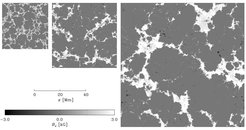Supercomputer can shed light on sunspot formation
A group of researchers tests a hypothesis of near-surface origin of sunspots with the power of supercomputers.
The SPOTSIM project, which studies the formation of sunspots, has been awarded competed time on the Mare Nostrum supercomputer in Spain. The awarded resources amount to 20 million CPU hours - a computing time equal to approximately 500 years on a normal laptop. The group of researchers including scientists from the Max Planck Institute for Solar System Research (MPS) in Germany and the Aalto University in Finland hopes to pinpoint the role played by turbulent plasma flows within the Sun.

Sunspots are dark areas of strong magnetic field strength on the Sun’s visible surface, the photosphere. Following an approximately eleven year cycle, these areas cover the Sun’s surface more or less abundantly. In phases when many sunspots can be seen, the Sun is especially active. Understanding where and how sunspots originate can therefore help scientists understand what processes drive solar activity.
There are two competing models for how sunspots are formed. According to one theory, the building blocks of the solar magnetic fields are thin tube-like structures at the bottom of the Sun's convection zone in the thin tachocline at a depth of 200,000 kilometres. From there the tubes erupt to the surface and form sunspots.
“This model does not take into account turbulence”, says Maarit Käpylä from the MPS and the Aalto University in Finland. In the model studied in the SPOTSIM project, sunspots are believed to form near the Sun's surface, in its convection zone. “Meteorologists say that low pressure in the Earth's atmosphere is filled when air flows into them from the surroundings. Our belief is based on similar turbulent and magnetic pressure in the Sun's convection zone, which is modified due to the large-scale magnetic field”, Petri Käpylä from the Leibniz-Institute for Astrophysics in Germany and the Aalto University adds. As a result of the negative overall impact of this, plasma can collapse, which causes magnetic fields to grow stronger locally and allows the formation of sunspots to begin.
The simulations necessary for modelling these processes are exceptionally large; one data cube in one simulation is approximately 700 gigabytes in size and one simulation produces tens of data cubes. The SPOTSIM partners now hope to gain new insights with the help of the Mare Nostrum supercomputer.
The new model would influence the Sun's dynamo theory as a whole as well as the understanding we have of the formation and development of the Sun's magnetic field. If successful, the computations would significantly advance our understanding of the challenging full picture of the Sun. This picture also includes space weather and climate.
Participants in the SPOTSIM – Spot-forming convection simulations research project include Petri Käpylä (Aalto University and the Leibniz-Institut für Astrophysik Potsdam (AIP)), Maarit Käpylä (Max Planck Institute for Solar System Research and Aalto University), Nishant Singh and Jörn Warnecke (Max-Planck-Institute for Solar System Research) as well as Axel Brandenburg (NORDITA and the University of Colorado Boulder).
